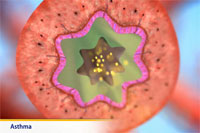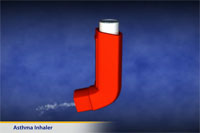
Exercise-Induced Asthma in Children
What is exercise-induced asthma?
Asthma is a chronic (long-lasting) lung disease in which the lining of the airways of the lungs is often swollen or inflamed. It causes wheezing, coughing, shortness of breath, and chest tightness. Exercise-induced asthma is a form of asthma that some children have during or after physical activity.
How does it occur?
When a child has asthma, the muscles around the airways tighten and the lining of the airways swells and produces thick mucus. This causes the airway to narrow and makes it harder to breathe. This breathing difficulty is called an asthma attack. In exercise-induced asthma, this can occur:
- during or after vigorous physical activity
- when the air is cold
- when the humidity is very low or high
- when there is a lot of air pollution
- when there are a lot of allergens in the air.
For many children, running or riding a bike in the cold air may trigger symptoms. Crying and temper tantrums may also trigger an asthma attack in very young children.
What are the symptoms?
The symptoms of exercise-induced asthma include:
- wheezing (a high pitched whistling sound heard during breathing)
- coughing with exercise
- shortness of breath
- chest tightness
- fatigue
- not wanting to participate in vigorous play or physical activities
How is it diagnosed?
Your child’s healthcare provider will ask about breathing problems after exercise. Your child will have a physical exam, and may have one or more breathing tests. Your child may be asked to run on a treadmill or to exercise outside the office. After this exercise, the healthcare provider will check for wheezing and other symptoms.
Your healthcare provider may give you a small device called a peak-flow meter. This device measures the fastest speed your child can blow air out of his lungs after a deep breath. During an asthma attack brought on by exercise, the peak flow measurement will be less than what is normal for your child.
How is it treated?
Exercise-induced asthma can be successfully treated with medicine. A quick relief inhaler medicine is prescribed. Examples of these medicines are albuterol and pirbuterol. They work fast to relax the muscles of the airways. This kind of medicine is usually given 15 to 30 minutes before exercise. It can prevent symptoms in people with exercise-induced asthma.
The use of inhaled steroids may help. Inhaled steroids reduce swelling, inflammation and mucus in the airways. This helps control and prevent asthma symptoms. Inhaled steroids can also help keep the airways from being too irritable. Inhaled steroids help with long-term asthma control. They do not immediately open the airways. They do not provide quick relief of wheezing in acute asthma attacks. For acute asthma attacks, your child will need a quick-relief medicine.
How can I take care of my child?
If your child has exercise-induced asthma, let coaches and teachers, who supervise your child know what to do to help your child.
Your child does not need to avoid all exercise and other physical activities. Doing warm-up exercises before a vigorous workout may help prevent an exercise-induced asthma attack.
Your child may need a few days to recover from a viral illness. In this case, he may need to avoid gym class or sports for a short time. Some children have more symptoms during strenuous activity in cold, dry air. During the winter your child may need to exercise indoors or wear a mask when exercising outside. Wearing a mask warms the air before your child inhales it. You may also need to be aware of conditions such as air pollution or allergens such as dust or pollen.
Your child can usually avoid symptoms by using a quick-relief medicine 15 to 30 minutes before exercise. If your child takes a quick-relief medicine before exercise and symptoms do not get better, repeat the dose after exercise is stopped.
If your child regularly has a lot of symptoms even after using a quick-relief medicine, talk with his healthcare provider.
When should I call my child's healthcare provider?
Call IMMEDIATELY if your child:
- has severe wheezing
- is having trouble breathing
- has wheezing that has not improved after the second dose of asthma medicine
- has a peak flow of less than 50% of the personal best.
Last modified: 2010-12-13
Last reviewed: 2010-12-13


